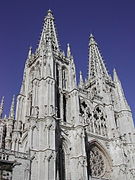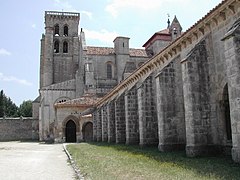Burgos
| Burgos municipality | ||
|---|---|---|
 Burgos - city view
|
||
| coat of arms | Map of Spain | |

|
|
|
| Basic data | ||
| Autonomous Community : |
|
|
| Province : | Burgos | |
| Comarca : | Alfoz de Burgos | |
| Coordinates | 42 ° 21 ′ N , 3 ° 42 ′ W | |
| Height : | 865 msnm | |
| Area : | 107.06 km² | |
| Residents : | 175,821 (Jan 1, 2019) | |
| Population density : | 1,642.27 people / km² | |
| Founding: | 884 | |
| Postal code : | 09001-09007 | |
| Municipality number ( INE ): | 09059 | |
| administration | ||
| Website : | Burgos | |
Burgos is the capital of the province of the same name in the autonomous community of Castile-León (Castilla y León) with 175,821 inhabitants (as of January 1, 2019 ) . The city is located on the Camino de Santiago ( Camino Francés ) and the Camino del Cid .
Toponym
There are several explanations for the origin of the place name Burgos. Most point to the Latin Burgus , which was formed from the Greek Πύργος / pyrgos and means "tower", "watchtower" or "castle hill". Others derive the city name from the German borg (= "mountain"). The Franciscan Diego de Guadix († 1615) meant with Arabic بورجوا(thatched house) to recognize an Arab origin, an opinion that is no longer shared today. Vegetius derives the name from bergus , burgus , which means "small castle". After all, there is talk of a castle that has become synonymous with the city that developed from it.
Location and climate
The city of Burgos lies on both banks of the Río Arlanzón , a tributary of the Duero , at an altitude of approx. 855 m in the northeast of the Iberian Meseta . The Spanish capital Madrid is about 250 km (driving distance) to the south; the Cantabrian port and industrial city of Santander is about 130 km (as the crow flies) north. The climate in winter is cold, but in summer it is warm to hot; the rather sparse rain (approx. 575 mm / year) falls - with the exception of the summer months - over the year.
Population development
| year | 1857 | 1900 | 1950 | 2000 | 2017 |
| Residents | 26,086 | 30,167 | 74,063 | 163,360 | 175,623 |
The continuous and significant increase in population since the 19th century is largely due to the mechanization of agriculture , the abandonment of small farms and the resulting lack of jobs in the countryside as well as the migration of many families to the larger cities ( rural exodus ). Smaller communities in the vicinity of the city were also repeatedly incorporated.
economy
Burgos has been an important economic center in northern Spain since the Middle Ages. There was heavy industrialization in the 20th century , especially with the creation of large industrial areas in the 1970s. Today Burgos is a predominantly industrial city, but the ever-expanding service sector has increased occupancy and development. Burgos is home to some of the companies with the highest turnover in Castile and Leon, such as Grupo Antolin , Campofrío and San Miguel . The machine tool manufacturer Nicolás Correa is headquartered in Burgos.
history
The first traces of settlement on the chain of hills dominating the city of San Miguel date from the Neolithic , the first permanent settlement was an oppidum from the Iron Age (700–500 BC), which was located on the site of today's castle ruins. In Roman times, the area was on the road connecting Asturica Augusta ( Astorga ) and Burdigala ( Bordeaux ), but there are no traces of a larger settlement. In the 7th / 8th In the 19th century, the area around Burgos was recaptured from the hands of the Moors by the kings of Asturias . A castle was built in 884 by the Castilian Count Diego Rodríguez Porcelos on the orders of King Alfonso III. erected by Asturias as an important fortification in the fight against the Moors. In 931, Fernán González , the first Count of Castile to be independent from the Kingdom of León , appointed Burgos as the capital of his dominion. Burgos became the coronation city of the kings of Castile in the 11th century , which underlines its special importance. The most famous Spanish hero of the Middle Ages, Rodrigo Díaz de Vivar, called El Cid , who is buried with his wife Jimena in the later built cathedral of Burgos , also came from the immediate vicinity of the city . After the conquest of Toledo by Alfonso VI. (1085) the importance of Burgos lost a little, but the city remained an important economic, cultural and political center in northern Spain.
During the Spanish Civil War , Burgos was the base of General Franco's nationalist government.
In a bomb attack on July 29, 2009 in front of a police barracks around 4 a.m., dozens of people were injured and surrounding houses were badly damaged. The attack was carried out with a vehicle prepared with explosives and is attributed to Eta .
Attractions
Buildings
- The most important sacred building in the city is the Gothic cathedral .
- There are also numerous other churches and monasteries.
- The Arco de Santa María and the Casa del Cordón are the most important secular buildings in the city.
Museums
Monasterio de las Huelgas
Statue of the Cid
Town twinning
-
 Bruges (Belgium)
Bruges (Belgium) -
 Loudun and Pessac (France)
Loudun and Pessac (France) -
 San Juan de los Lagos and Morelia (Mexico)
San Juan de los Lagos and Morelia (Mexico) -
 Valencia (Spain)
Valencia (Spain) -
 Vicenza (Italy)
Vicenza (Italy) -
 Settat (Morocco)
Settat (Morocco)
gastronomy
A black pudding called Morcilla de Burgos , made from blood , fat and rice , is available in Burgos . The Queso de Burgos is a cream cheese made from sheep's milk .
Personalities
- Lesmes of Burgos (around 1030-1097), abbot and saint
- Abner von Burgos (1270–1347), doctor and philosopher
- Pedro de Lerma (around 1461–1541), theologian and first chancellor of the University of Alcalá
- Francisco de Vitoria OP (around 1483–1546), founder of the Salamanca School .
- Francisco de Enzinas (around 1518–1552), humanist
- Diego de Enzinas (around 1520–1547), Protestant
- Alonso de Salazar y Frías (around 1564–1635), canon lawyer, priest and inquisitor
- Julián Oñate (1840–1899), painter
- Victoriano Crémer Alonso (1906 / 1907–2009), writer and journalist
- Daniel Arce (* 1992), athlete
Web links
- Detailed city description
- Official website of the city administration (span.)
- Burgos for everything about Spain
Individual evidence
- ↑ Cifras oficiales de población resultantes de la revisión del Padrón municipal a 1 de enero . Population statistics from the Instituto Nacional de Estadística (population update).
- ↑ See: Stefan Ruhstaller: La Recopilación de algunos nombres arábigos de Diego de Guadix como temprano diccionario toponímico . In: Vox Romanica , Vol. 71 (2012), pp. 163-196.
- ↑ Burgos - climate tables
- ^ Burgos - population development
← Previous location: Villafría 7.8 km | Burgos | Next village: Villalvilla 7 km →









